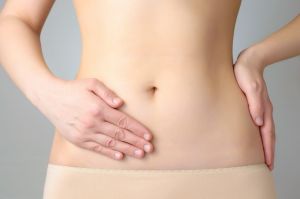What is Endometriosis?
In patients with Endometriosis, tissue that is similar to the one that forms the uterus mucosa is growing outside (ectopic) of the uterus, often in the ovaries, the vagina or the bowel[1]. The underlying process is inflammation, which can be addressed with modalities such as cold laser therapy.

What are the symptoms?
As this ectopic tissue is identical to the uterus tissue on a cellular level, it behaves as though it was inside the uterus and also undergoes hormone dependent changes during the menstrual cycle, causing bleeding and pain [2]. Other than in the uterus, that ectopic menstrual tissue is trapped in its unnatural environment and has no way to escape the body, which causes inflammation.
The clinical signs the patients report accordingly follow a periodical pattern in their intensity, usually with their peak during menstruation. The clinical presentation depends on where the ectopic tissue is growing. It can present as a condition similar to inflammatory bowel diseases, musculoskeletal pain, or can lead to infertility, if the ovaries are affected. A laparoscopy can provide information about the location, extent and size of the endometrial implants to help determine the best treatment options.
A more prevalent condition than reported?
10% of Australian women will suffer from endometriosis at some point in their lives [3] but of course this is only the reported cases of the condition. The disease often evolves in young age and remains undiagnosed for an average of 7-10 years due to the variable and unspecific clinical presentation.
Because there is no cure for Endometriosis, the disease accompanies patients for years. The pain caused by endometriosis often impacts a woman’s day to day life, which can have detrimental emotional and economic side effects. The healthcare costs and loss of productivity incurred because of endometriosis is estimated to cost Australians $7.7 billion annually [3].
Treatment options
Due to the lack of curative treatment options, the therapy focuses on the symptoms and pain management [4]. NSAID and other analgesics are commonly used but bring along their own risks and side effects. Surgical intervention to remove the ectopic tissue is often advised however many endometriosis can often return at a later stage.
How cold laser therapy can help
In the first instance the highly researched analgesic and anti-inflammatory effects of laser therapy can help to reduce the pain and inflammation that is produced by endometriosis. Over cumulative treatments low level laser can improve the state of the tissue and bring systemic levels of inflammation down. Utilising laser therapy before and after surgical removal of endometriosis implants can help to a) improve the condition of tissue before surgery and b) help to speed up post-operative recovery (with less pain). If you would like to learn more about how we could help with treating endometriosis please call or email us.
References
- Gyn Care. The Emotional Side of Endometriosis Pain. 2015 2015-10-17 04.01.2019]; Available from: https://innovativegyn.com/blog/the-emotional-side-of-endometriosis-pain/.
- Fraser, I.S., Recognising, understanding and managing endometriosis. Journal of human reproductive sciences, 2008. 1(2): p. 56-64.
- Endometriosis Australia. Endometriosis Facts. 2018 [cited 2019 04.01.2019]; Available from: https://www.endometriosisaustralia.org.
- Parasar, P., P. Ozcan, and K.L. Terry, Endometriosis: Epidemiology, Diagnosis and Clinical Management. Current obstetrics and gynecology reports, 2017. 6(1): p. 34-41.
